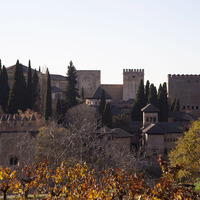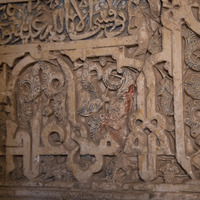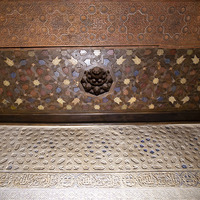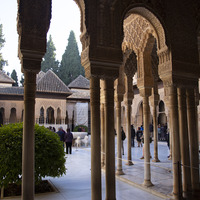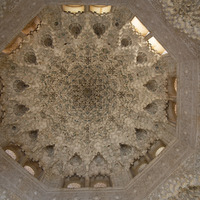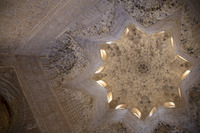Alhambra
Date:
Begun in the first quarter of the fourteenth century with major additions throughout the century
Location or Findspot (Modern-Day Country):
Spain
Description:
Under Sultan Ismail I (r. 1314–25), the Nasrids began work on a fortified complex outside Granada. The complex is generally called the Alhambra—al-Hamra' in Arabic, or "the red," the Nasrid dynastic color—and comprised a series of palaces and gardens. The Comares and the Palace of the Lions were built under Sultan Yusuf I (r. 1333–54) and his son, Muhammad V (r. 1354–59, 1362–91). The nearby Generalife (Gardens of the Overseer) was a summer palace on a peak to the east.
At the Comares, luxury textiles were sometimes displayed in the Mexuar (place of counsel), which served as a council chamber or throne room of the Comares. The Patio of the Gilded Room is named after a small room (the Cuarto Dorado) to its north and the gold of its partly gilded ceiling. It leads to the Court of the Myrtles, which surrounds a long reflecting pool framed by marble walkways. The so-called Hall of the Boat, or Sala de la Barca, is also named after a ceiling, in this case one resembling an inverted ship (the original was destroyed by fire). The Hall of the Ambassadors was a reception area in which the sultan awaited visitors.
The Palace of the Lions housed royal chambers, a bath complex with steam rooms, and possibly a madrasa. This palace is named after the twelve marble lions supporting a marble basin in the courtyard. South of the Court of the Lions was the the Hall of Abencerrajes, the name of a prominent Nasrid family, and to the east the Hall of Justice (or Hall of the Kings). This hall includes a special technique not used elsewhere in the Alhambra: its eastern side alcoves are painted in egg tempera on leather, then varnished with wax. To the north of the Court of the Lions is the Hall of the Two Sisters (named after two large marble paving stones), which leads into the Lindaraja (or Daraxa) mirador, from which one views the garden below.
At the Comares, luxury textiles were sometimes displayed in the Mexuar (place of counsel), which served as a council chamber or throne room of the Comares. The Patio of the Gilded Room is named after a small room (the Cuarto Dorado) to its north and the gold of its partly gilded ceiling. It leads to the Court of the Myrtles, which surrounds a long reflecting pool framed by marble walkways. The so-called Hall of the Boat, or Sala de la Barca, is also named after a ceiling, in this case one resembling an inverted ship (the original was destroyed by fire). The Hall of the Ambassadors was a reception area in which the sultan awaited visitors.
The Palace of the Lions housed royal chambers, a bath complex with steam rooms, and possibly a madrasa. This palace is named after the twelve marble lions supporting a marble basin in the courtyard. South of the Court of the Lions was the the Hall of Abencerrajes, the name of a prominent Nasrid family, and to the east the Hall of Justice (or Hall of the Kings). This hall includes a special technique not used elsewhere in the Alhambra: its eastern side alcoves are painted in egg tempera on leather, then varnished with wax. To the north of the Court of the Lions is the Hall of the Two Sisters (named after two large marble paving stones), which leads into the Lindaraja (or Daraxa) mirador, from which one views the garden below.
Relevant Textbook Chapter(s):
10
Repository and Online Resources:
• Take a virtual walking tour of the Alhambra.
• Listen to a Spotify playlist of music from al-Andalus put together by the Museo Arqueológico Nacional, Madrid.
• Watch a video on "Water and Sound in Islamic Architecture" here.
• See panoramic views of many spaces in the Alhambra via Columbia University's Media Center for Art History.
Image Credits:
Linda Safran, Navid Jamali


